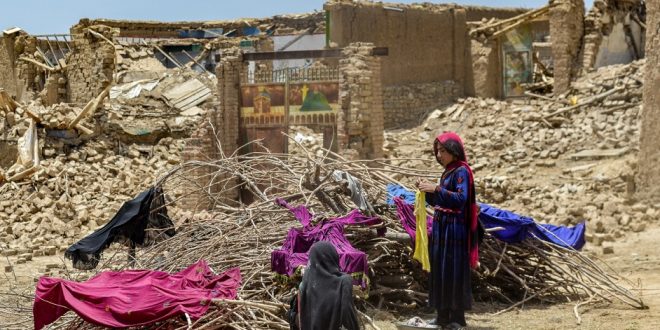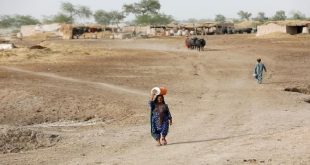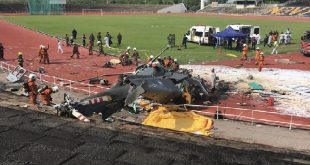29-06-2022
By SJA Jafri + Bureau Report
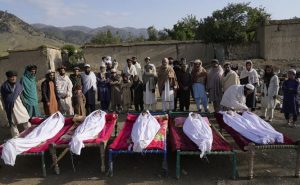 GAYAN/ KABUL/ ISLAMABAD: When a magnitude 5.9 earthquake struck eastern Afghanistan last week, Naqib lost his home and nearly his whole family. His parents and four siblings now lie buried on a hilltop overlooking the remote district of Gayan in hard-hit Paktika province. The 11-year-old now only has one sister, Nesab, who is four.
GAYAN/ KABUL/ ISLAMABAD: When a magnitude 5.9 earthquake struck eastern Afghanistan last week, Naqib lost his home and nearly his whole family. His parents and four siblings now lie buried on a hilltop overlooking the remote district of Gayan in hard-hit Paktika province. The 11-year-old now only has one sister, Nesab, who is four.
The little girl is glued to his side, quietly listening as her brother recalls the June 22 disaster.
“I was buried under the rubble with Nesab. We were screaming. My uncle came and helped us out of the destroyed house. It was dark, but I saw that nobody else in my family was screaming. They were all dead.”
In the morning, Naqib watched as relatives washed the bodies of the dead before burying them. It happened in a blur, and his eyes fill with tears at the memory. His sister is confused, he admitted, one moment asking when her parents will wake up, the next declaring those dead.
A total of 35 people have died in the children’s extended family; 45 were injured, some of them severely.
Naqib’s story is all too common. More than 1,000 people have been killed and 2,000 injured in what has been recorded as Afghanistan’s worst earthquake in 20 years. According to the country’s Ministry of Public Health, 35 entire villages have been destroyed or damaged. In Gayan alone, at least 250 people have died.
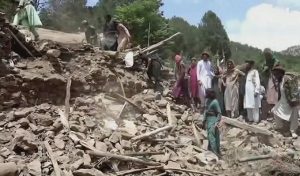 Families affected by the disaster now say they are struggling to see a future in the already impoverished area that has long been cut off from the rest of the country, with no electricity and only poor phone signal available.
Families affected by the disaster now say they are struggling to see a future in the already impoverished area that has long been cut off from the rest of the country, with no electricity and only poor phone signal available.
Since the earthquake, aid agencies, Taliban officials and Afghans from all over the country have flooded in to help. Dozens of helicopter flights have brought in aid and evacuated the injured, while truckloads full of food, blankets and tents navigated the difficult terrain all the way from the capital, Kabul, a roughly nine-hour drive.
“This area saw a lot of fighting during the war, so only a few people came here,” said Naqib’s uncle and now closest relative, Rahmatullah Rahmani. He was referring to fighting between the US invasion of 2001 and its withdrawal in 2021, during which time government forces, supported by the US and other Western forces, fought the Taliban.
On August 15, 2021, the Taliban took control of the country.
“The Taliban destroyed a lot, and so did the Americans. It was dangerous and that’s why we don’t have good roads, schools or clinics here,” added the 42-year-old, who also lost his wife and two daughters last week.
“We used to manage before, but I don’t think we can after the earthquake. In the last few days, people arrived to bring food and tents, but how much longer are they going to stay? Soon we will be left alone and we don’t know how we are going to rebuild our houses.”
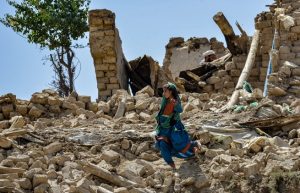 Qalandar Ebad, the Taliban’s minister of public health, admitted to the challenge. “The condition is critical. People have lost their homes, but they are also affected psychologically. Many children have seen their family members die, which is traumatizing,” he said.
Qalandar Ebad, the Taliban’s minister of public health, admitted to the challenge. “The condition is critical. People have lost their homes, but they are also affected psychologically. Many children have seen their family members die, which is traumatizing,” he said.
He added the Taliban would be supporting rebuilding efforts and psychological care for victims, but also hoped the Afghan people would help.
“I don’t think any other country has more humanitarians than Afghanistan,” he claimed, sitting cross-legged in a tent in Gayan, where he met other senior officials, aid agency representatives and Afghan volunteers.
Since the Taliban takeover, Afghanistan has slipped even deeper into a pre-existing humanitarian crisis that has seen a down-spiraling economy, skyrocketing poverty levels and widespread unemployment.
In Gayan, a rocky, mountainous terrain unsuitable for farming, men have traditionally sought work opportunities in other Afghan cities, sending cash home whenever possible. They now say they will be staying home, working to rebuild their own lives.
Immediately after the earthquake, the United Nations estimated that $15m would be required to respond to people’s immediate needs. The world body has now appealed for $110m to cover the quake response as billions of dollars in Afghan funds remain frozen in US accounts and international sanctions hamper efforts to help those worst affected.
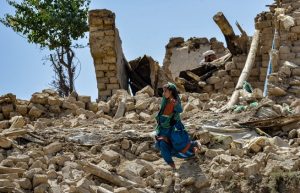 Rahmani confirmed the Taliban had promised him 100,000 Afghani ($1,300) for each death in the family, saying that while he did not know when he would be receiving the cash, he was thankful, and hoped to put it towards rebuilding his home. He will be opting for a house stronger than the mud-brick building he previously lived in.
Rahmani confirmed the Taliban had promised him 100,000 Afghani ($1,300) for each death in the family, saying that while he did not know when he would be receiving the cash, he was thankful, and hoped to put it towards rebuilding his home. He will be opting for a house stronger than the mud-brick building he previously lived in.
“I don’t know where the money will come from, because such a house is more expensive. It’s the only option though if I want to keep my family safe,” he said, explaining that he would also be raising orphaned Naqib and his sister Nesab.
Gayan’s District Governor Malawi Rahmatullah Darwish – previously a Taliban commander of more than 100 soldiers said he would be helping, too.
“Right after the earthquake struck, I organized 40 of my staff members to help remove rubble, dig up people, and call ambulances. We will help rebuild these homes too – with our own hands,” he said.
Some locals remain suspicious and claim the Taliban have already prioritized giving aid to their supporters in the area instead of sending it to those worst hit – and that people from far-away areas that had no quake damage had come in to fraudulently claim food aid.
Rahmani said most people in his village were trying to press on, even though they had lost hope.
He stands amidst the rubble of his own house; a walled compound next to where Naqib had previously lived with his own parents.
“If there isn’t another earthquake to kill us, poverty might. I don’t know what the future brings, but I have to work hard to rebuild our lives, for my family.”
 Pressmediaofindia
Pressmediaofindia
